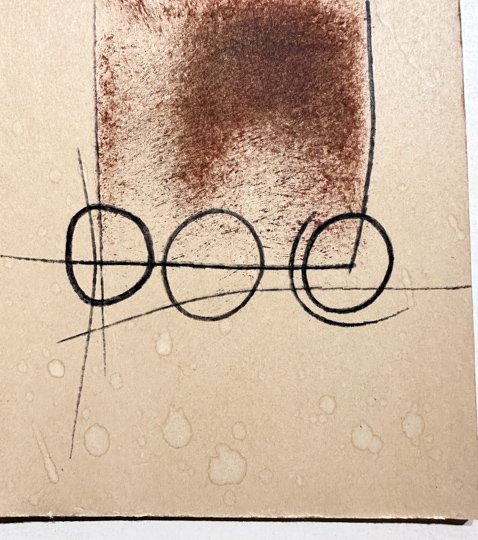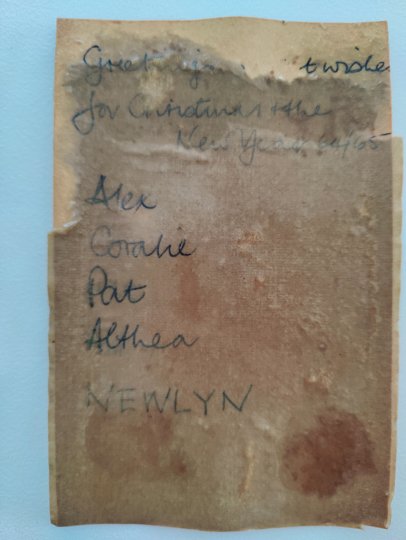Mid-Century Abstract Art - Buying and Restoration challenges
Alexander Mackenzie (1923 – 2002) - Post War Modernist Artist & Teacher
We live in a world that expects perfection, but some things are just ‘not’ perfect. Mid-Century Abstract Art can appear with some war wounds, dinks, scratches and even water marks. The question is, do you restore it or leave it alone? It is always a good idea to seek professional advice if your selected artwork looks like it needs a little help.
A little mid-century abstract art piece is found, but what is it?
So our challenge started whilst sourcing some nice oil paintings for the Rastall Art gallery. Tracy, my wife and gallery partner, found, inspected and fell in love with a little mid-century abstract mixed media artwork on card. It was sunlight damaged, had splash marks, creases and was stuck to a backing card on a broken 1970’s plastic frame with powerful adhesive.
To add to these potential issues, she was a determined buyer and probably paid more than was sensible for the condition it was in, at this Modern British Art auction. However, she has a habit of picking some extraordinary artworks that, over time, proves she is good at spotting the hidden gem!
The Post-Auction Conversation
I asked “What have you bought?”, the reply came “I am not sure, but it looks like a abstract taxi”. “Who is it by?” I asked. Tracy replied “I am not sure, but I really like it, and, it reminds me of a 3 wheeled taxi”. I asked (hopefully)“Is it signed?”, “Nope” came the reply.
I have looked it up and “3 wheeled taxi” does not appear to be an official answer in any art terms glossary for abstract art.
To be fair, it was attributed to the St Ives post-war modernist artist Alexander Mackenzie, but it was unsigned.
I asked “What does it say on the back?” to which Tracy replied “You can’t see the back as the card seems stuck with glue on this plastic 70’s frame”. My heart sank, but at that point it became obvious she loved it and it was never likely to get anywhere near our retail website.
For context, Tracy is a highly intelligent woman who interrogates the risks around Financial Services technology systems in the city. So when she is daft or flippant with me, I already know she is 3 steps ahead and I have lost the battle. Think Sun Tzu art of war and you are not far off.
Now, to restoring this little abstract art work
Time to assess the artwork back at our office. Tracy has selected an interesting piece of Mid-Century Abstract art in graphite & paint, that maybe from the hand of the modernist artist Alexander Mackenzie. It measures about 15cm x 10cm has been sun-bleached, has splash water marks to the front, an acid leaching reaction from the card backing board and a serious amount of adhesive to the very back of the card that was attached to a broken plastic frame. Professional restoration was going to be required, this was not a perfect world situation for our little taxi friend.
Restoring this abstract artwork, the details.
On discussion with our professional restorer, the front image would be lifted from the acidic backing board, a simple clean to the paper image (subject to the artists’ media taking the process well) and a re-laying of the original to museum quality restoration material to stop any further degradation.
For those interested, the stepped process for the conservation of our lovely little mid-century abstract art piece included:
Dry Clean
Test
Remove from backing Card by Delamination to thin paper layer
Photograph process
De-acidify
Clean
Buffer
Stabilise
Line onto over-sized 100% cotton Museum board using wheat starch paste
Wrap for storage/transport
It’s all about an artwork’s provenance.
So the conservator begins and this is where it gets interesting. As the layers were gently separated the story of the artwork started to appear.
What has Tracy really bought?
Tracy’s art radar is correct again. The image shows the wet separated layers of a Christmas Card from the Mackenzie family saying “Greetings & Best Wishes for Christmas & the New Year 64/65” -Alex, Coralie, Pat, Althea NEWLYN.
Now confirming Tracy had successfully bought a small unique original artwork (not a print/litho) by Alexander Mackenzie which was a 1964 Christmas Card to a local Cornish family.
It has now been fully restored and framed behind UV protective glass. This is an early piece as Mackenzie had his first solo show at Waddington Gallery London in 1959 and then the Durlachers Gallery in New York in 1960, but the further commercially successful exhibition came some 40 years later in 2000 with a solo show at Austin Desmond Fine Art.
If you are a collector of British mid-century abstract art this is quite a lovely little find, with an interesting story uncovered by it’s professional restoration.
Should it have been restored?
In my view it was the only way to stabilise and provide a new foundation under this artwork on paper, to stop further acidic deterioration. The artists’ materials of graphite and paint were not the problem, it was the backing materials and glue.
Now the little (Alexander Mackenzie) ‘taxi’ sits on cotton museum quality board, is framed and under art glass, it should be safe for many years to come.
But is it a taxi?
We don’t really know and probably never will, but during research we found the following obituary for Alexander Mackenzie.
Peter Wakelin wrote in the Guardian “From 1941 to 1946 he (MacKenzie) served with the Inns of Court Regiment in Europe, driving an armoured car on reconnaissance missions: he never lost the ability to reverse at speed”.
Read the full Guardian Obituary for Alexander MacKenzie
Therefore, it could be an armoured car which would be an odd subject for a Christmas Card!
But is it abstract?
If it is so obviously a three wheeled taxi as Tracy states, can she accurately claim it to be mid-century abstract art?
Yes - Painted by a member of the Penwith Society of Arts in 1964, it is a remarkable simple, bold and fun little abstract work that feels like it was created to bring a smile to everyone at Christmas.
If you would like to view this lovely mid-century abstract piece, alongside artwork that is for sale in our gallery, please call us on 07990831917 or email simon@rastall.art to book your personal viewing.
Alexander MacKenzie (1923-2002)
Painter born in Liverpool and resided in Yorkshire prior to active service in World War II. He enrolled at Liverpool College of Art, 1946-50, and while there he was briefly a member of the Liver Sketching Club before moving to Cornwall in 1951.
He was on the staff of Penzance School of Art 1951-64 and later at Plymouth until the early 1980’s where he eventually became Head of Fine Art. He was an elected member of the Penwith Society of Arts, 1952 and was also a member of the NSA. He joined the Waddington Galleries, London, in 1958 holding his first one-person show there in 1959.
Mackenzie also exhibited at the Plymouth Society of Artists and held joint exhibitions with Bryan Wynter at Plymouth in 1970, and with Denis Mitchell and John Wells also in Plymouth in 1975. He also exhibited at the Redfern Gallery and in 1960 staged a solo show at Durlachers Gallery in New York. His commercially successful solo exhibition at Austin Desmond Fine Art in 2000 was his first London exhibition since 1968, though his work was exhibited regularly in group surveys of 1950’s art and his works from that period and now commands growing prices in the auction rooms.
His work is in the collections of ACGB, Barnsley Museum Services, Cornwall County Council, Gallery Oldham, Gulbenkian Foundation, Leamington Spa Art Gallery, Pallant House Gallery, Plymouth Art Gallery, Salford Art Gallery, Tate Gallery, York Art Gallery and in the National Gallery of New South Wales, Sydney.
Source: www.artbiogs.co.uk






